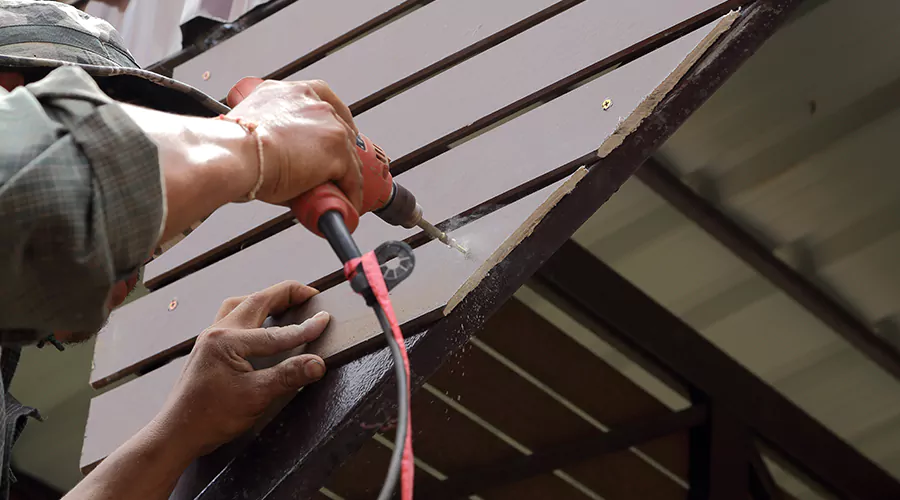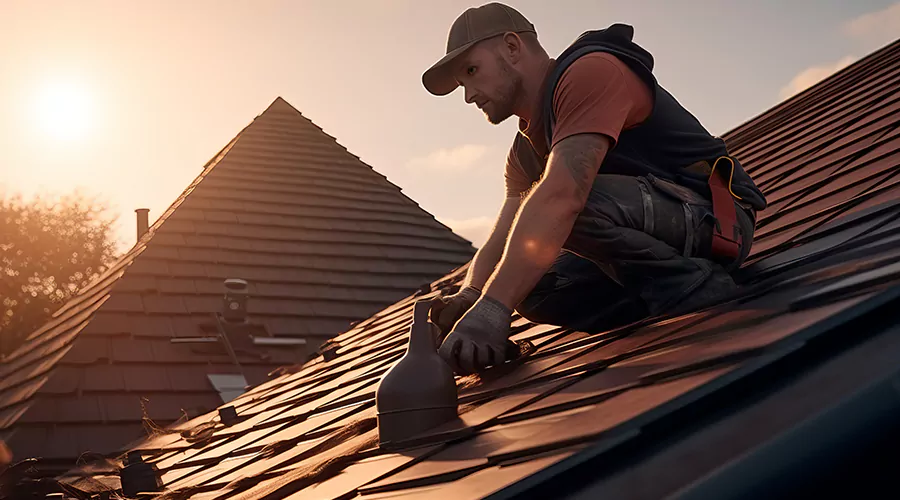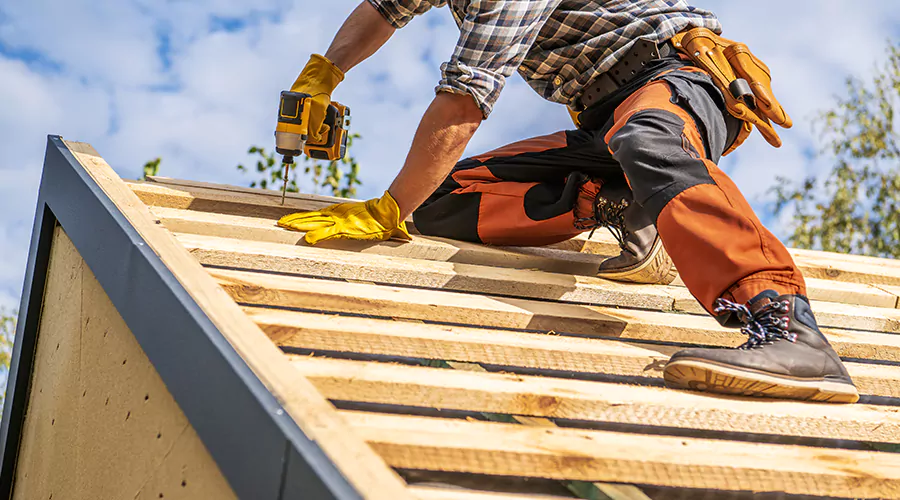The allure of self-reparation for households can be a great means to save money and learn a new skill. However, when it comes to roof maintenance and repair, proper caution is crucial. The elevated working positions coupled with the labor-intensive nature of roof maintenance can pose significant safety risks. As such, here is a guide to some essential precautionary measures for DIY roofers.
Use Appropriate Safety Gear
When engaging in do-it-yourself (DIY) roofing projects, ensuring your safety should be of paramount importance. Wearing appropriate safety gear is an essential precautionary measure to protect yourself from potential hazards. A sturdy and well-fitted helmet safeguards your head from falling objects or accidental slips. Utilizing safety goggles shields your eyes from debris and dust, reducing the risk of injuries. Invest in a reliable pair of work gloves to safeguard your hands during handling of materials and tools, preventing cuts and abrasions. Sturdy, non-slip footwear is crucial for maintaining stability on the roof surface. Additionally, a safety harness, when working at heights, is non-negotiable to prevent falls and ensure you have a secure anchor point.
Monitor Weather Conditions
Monitoring weather conditions is a fundamental precautionary measure for DIY roofers to ensure a safe and efficient work environment. Before embarking on any roofing project, it is crucial to stay informed about the current and upcoming weather forecasts. Adverse weather conditions, such as rain, strong winds, or storms, can pose serious risks when working at heights and on slippery surfaces. Sudden weather changes can compromise the stability and safety of the roofing structure. It is advisable to schedule roofing activities during periods of dry and mild weather to minimize the likelihood of accidents. Being vigilant about the weather allows DIY roofers to plan their work accordingly, ensuring the safety of both themselves and the structural integrity of the roofing project. In case of unexpected weather shifts, having a contingency plan and being prepared to halt work until conditions improve is a responsible and necessary approach to safeguard against potential accidents.

Ladder Safety
Ladder safety is a critical precautionary measure for DIY roofers to minimize the risk of accidents and injuries. When using ladders for roof access or to reach elevated areas, it is imperative to follow proper safety guidelines. Ensure the ladder is on a stable and level surface, and use leg levelers or stabilizers if needed. Maintain a three-point contact with the ladder at all times: two hands and one foot, or two feet and one hand. Secure the ladder at the top to prevent it from slipping or shifting. Choose the right ladder height that allows safe access to the roof without overreaching. Inspect the ladder for any damage or defects before each use, and never exceed the ladder's weight capacity. If the roofing project requires extended time on the ladder, consider using a safety harness for added protection.
Avoid Working Alone
One of the cardinal rules of roof maintenance is never to work in isolation. In case of an accident, a partner can provide immediate assistance or call for help. Having a partner or helper can significantly reduce the risks associated with accidents and emergencies. Roofing tasks often involve working at heights and handling heavy materials, which can be challenging for a single person. Having an extra set of hands not only makes the work more manageable but also provides assistance in case of unforeseen circumstances. In the event of an accident or injury, having a companion nearby ensures prompt response and access to help. Moreover, collaborative efforts can enhance efficiency and contribute to a more accurate and secure execution of the roofing project.
Clear Work Area
Clearing the work area is an essential precautionary measure for DIY roofers to maintain a safe and organized environment during roofing projects. A clutter-free work zone minimizes the risk of tripping and facilitates smooth movement around the roof. Before starting any roofing tasks, remove tools, debris, and unnecessary materials from the work area. Secure loose items that could be blown away by the wind. Additionally, ensure that the roof surface is free of any obstacles that may impede safe footing. Properly store tools and equipment when not in use, and avoid leaving them scattered on the roof. By maintaining a clear and organized work area, DIY roofers not only reduce the chances of accidents but also enhance overall efficiency and precision in their tasks.
Early Morning or Late Afternoon Work
Choosing to work during the early morning or late afternoon is a strategic precautionary measure for DIY roofers to mitigate the risks associated with extreme temperatures. Roofing materials and surfaces can become excessively hot during the peak of the day, posing burn hazards and making the work more strenuous. By scheduling tasks during the cooler hours of the morning or late afternoon, DIY roofers reduce the likelihood of heat-related illnesses and discomfort. Moreover, cooler temperatures enhance the efficiency and safety of the work, allowing individuals to focus on the task at hand without the added stress of intense heat.
Know Your Limitations
Recognizing and understanding personal limitations is a fundamental precautionary measure for DIY roofers to prioritize their safety during projects. Roofing tasks often involve working at heights, handling heavy materials, and utilizing various tools, which can pose inherent risks. Before undertaking any DIY roofing project, individuals should assess their own physical fitness, experience level, and comfort with the tasks at hand. If the project seems beyond one's capabilities, seeking professional help or guidance is advisable. It's crucial to avoid pushing personal limits, as this can lead to accidents, injuries, or compromised structural integrity of the roofing work. Knowing when to ask for assistance or when to hire a professional ensures that the roofing project is completed safely and effectively.

Emergency Preparedness
Always keep a well-stocked first aid kit nearby and ensure you have a solid emergency plan. This should include knowing the quickest route to the nearest hospital and having an accessible phone to call for help if necessary. Before initiating any roofing project, DIYers should have a well-thought-out emergency plan in place. This includes having immediate access to a first aid kit, knowing the location of emergency exits, and having a communication plan to contact help if needed. Additionally, DIY roofers should be aware of the nearest medical facilities and emergency services. It's crucial to have emergency contact information readily available and to inform someone else about the ongoing roofing work, especially if working alone. Being prepared for unexpected incidents, such as accidents, adverse weather changes, or equipment malfunctions, enhances overall safety and ensures a swift and coordinated response in critical situations.
Roof maintenance is not a task to be taken lightly. Always follow these safety guidelines and err on the side of caution to prevent accidents. Despite these precautions, recognize that some jobs require the knowledge, skills, and equipment that only a professional roofer can provide.

